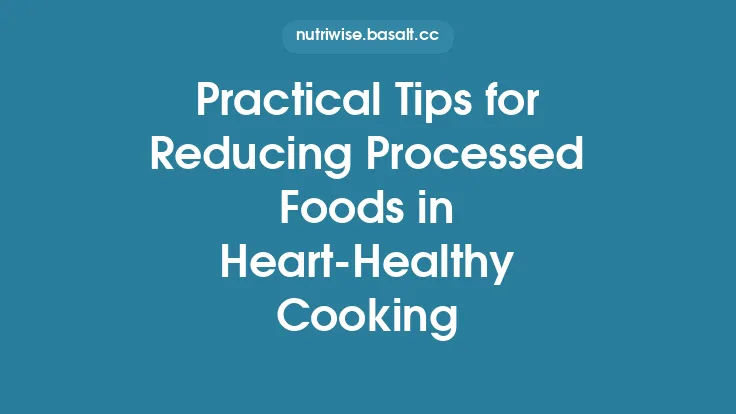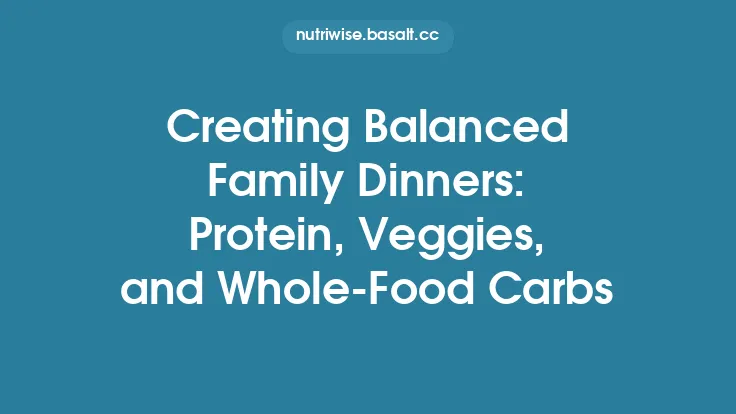When we think about meal preparation, the word “convenient” often conjures images of pre‑chopped vegetables, ready‑to‑heat packets, and a pantry stocked with shelf‑stable staples. While these shortcuts can save time, they also have the potential to alter the way our bodies break down and absorb nutrients. Striking a balance between convenience and optimal digestion means understanding which processing steps preserve the natural structure of foods, how they interact with our digestive system, and what practical strategies can be employed in the kitchen to keep meals both quick and gut‑friendly.
Understanding Minimal Processing
Minimal processing refers to techniques that make foods safer or more convenient without fundamentally changing their intrinsic composition. Typical examples include:
- Washing and sanitizing – removes surface microbes while leaving cellular structures intact.
- Trimming and portioning – reduces preparation time but does not involve heat, pressure, or chemical alteration.
- Refrigeration and controlled‑atmosphere storage – slows microbial growth without affecting macronutrient integrity.
- Gentle drying or dehydration – removes water to extend shelf life while preserving most nutrients, provided temperatures stay low.
These steps differ from more intensive methods (e.g., extrusion, high‑temperature cooking, or chemical fortification) that can dramatically reshape fiber matrices, denature proteins, or create novel compounds. By staying within the realm of minimal processing, we retain the food’s original physical architecture, which is a key determinant of how efficiently digestive enzymes can access nutrients.
The Role of Food Structure in Digestion
The human digestive tract relies on a cascade of mechanical and enzymatic actions. The efficiency of this cascade is heavily influenced by the physical form of the ingested food:
- Cell Wall Integrity – Plant cell walls, composed mainly of cellulose, hemicellulose, and pectin, act as a barrier to digestive enzymes. When these walls remain largely intact (as in lightly chopped or whole vegetables), the release of intracellular nutrients is slower, leading to a more gradual glucose appearance in the bloodstream and a prolonged feeling of satiety.
- Particle Size Distribution – Smaller pieces present a larger surface area relative to volume, allowing enzymes such as amylase, lipase, and proteases to act more rapidly. However, overly fine particles can accelerate gastric emptying, potentially causing spikes in post‑prandial blood sugar and reduced nutrient absorption downstream.
- Water Content and Matrix Hydration – Foods with higher intrinsic water (e.g., cucumbers, tomatoes) or those that have been lightly hydrated during preparation (e.g., rehydrated dried beans) facilitate enzyme diffusion. Conversely, overly dry or densely packed foods may impede enzyme penetration, leading to incomplete digestion.
By preserving the natural matrix while adjusting particle size to a moderate degree, we can create meals that are both easy to chew and digest without sacrificing the benefits of fiber and micronutrient release.
Selecting Ingredients for Digestive Harmony
When planning a minimally processed meal, consider the following criteria to maximize digestive comfort:
| Ingredient Category | Ideal Forms for Minimal Processing | Digestive Benefits |
|---|---|---|
| Whole Grains | Pre‚Äërinsed, dry‚Äësieved kernels (e.g., quinoa, farro) | Retain bran and germ, providing soluble and insoluble fiber that moderates glucose absorption and supports colonic health. |
| Legumes | Soaked, pre‚Äësorted beans or lentils (no pre‚Äëcooked) | Soaking reduces antinutrient levels (phytic acid) while preserving protein structure; cooking can be done quickly in a pressure‚Äëcooker or stovetop for a short period. |
| Root Vegetables | Peeled and cubed carrots, sweet potatoes, beets | Cutting into uniform cubes ensures even cooking; retaining skin when possible adds extra fiber. |
| Leafy Greens | Fresh, washed, and torn (not shredded) kale, spinach, arugula | Larger leaf pieces maintain cell wall integrity, slowing digestion and providing a steady release of vitamins and minerals. |
| Fruits | Whole berries, sliced apples, peeled citrus segments | Minimal cutting reduces exposure of sugars to oxidative enzymes, preserving antioxidant capacity. |
| Proteins | Fresh fish fillets, skinless poultry breasts, tofu blocks | Keeping proteins in larger pieces reduces surface area for rapid denaturation, allowing a more controlled enzymatic breakdown. |
| Healthy Fats | Extra‚Äëvirgin olive oil, avocado slices, nuts (unsalted, raw) | Fat droplets remain stable when added at the end of preparation, supporting micelle formation for fat‚Äësoluble vitamin absorption. |
Practical Meal‚ÄëPrep Techniques
1. Batch Washing and Sanitizing
- Cold‑water rinse with a mild acid – Adding a splash of lemon juice or a food‑grade acetic acid to the wash water can lower surface pH, inhibiting bacterial growth without altering food chemistry.
- Use of a salad spinner – Rapidly removes excess water, preventing dilution of natural flavors and reducing the need for additional cooking to evaporate moisture.
2. Controlled Cutting
- Uniform dice (½‑inch to ¾‑inch) – Strikes a balance between surface area and structural integrity. For leafy greens, a “hand‑tear” method preserves larger cell clusters.
- Avoid over‑processing – Refrain from using food processors for vegetables intended for raw consumption; the resulting puree can lead to rapid gastric emptying and less satiety.
3. Quick, Low‚ÄëHeat Cooking
- Steam‑blanching (2–3 minutes) – Brief exposure to steam softens cell walls just enough to improve digestibility while preserving most heat‑sensitive nutrients (e.g., vitamin C, folate). Immediately plunge into ice water to halt further cooking.
- Stir‑fry at medium heat (≤ 150 °C) – A short, high‑velocity stir‑fry can sear the exterior of proteins and vegetables, creating a flavorful Maillard surface without extensive protein denaturation. Keep the cooking window under 5 minutes.
4. Smart Storage
- Portion into airtight containers – Use glass or BPA‑free plastic containers with tight seals to limit oxygen exposure, which can degrade polyphenols and cause off‑flavors.
- Label with “use by” dates – Even minimally processed foods have a finite shelf life; a 3‑day window for fresh produce and a 5‑day window for cooked grains/proteins is a safe guideline.
- Refrigerate at 1–4 °C – This temperature range slows enzymatic activity and microbial growth while preserving texture.
5. Assembly at the Point of Consumption
- Add fats and acids last – Drizzling olive oil, a squeeze of lemon, or a dash of vinegar just before eating prevents premature oxidation and maintains emulsification properties that aid fat digestion.
- Mix gently – Over‑mixing can break down delicate structures (e.g., avocado flesh) into a puree, which may accelerate gastric emptying.
Nutrient Bioavailability Considerations
Even within the realm of minimal processing, subtle adjustments can influence how well nutrients are absorbed:
- Phytate Reduction – Soaking legumes and whole grains for 8–12 hours, followed by a brief rinse, activates endogenous phytases that hydrolyze phytic acid, thereby freeing bound minerals such as iron, zinc, and calcium.
- Enzyme Activation – Light mechanical disruption (e.g., chopping) can release endogenous enzymes like myrosinase in cruciferous vegetables, converting glucosinolates into bioactive isothiocyanates that support gut health.
- Synergistic Pairings – Pairing vitamin‑C‑rich foods (e.g., bell peppers) with iron‑rich plant proteins (e.g., lentils) enhances non‑heme iron absorption through the reduction of ferric to ferrous iron in the duodenum.
Tailoring Meal Prep to Individual Digestive Needs
Digestive tolerance varies widely among individuals. The following adjustments can help customize minimally processed meals:
| Digestive Concern | Adjustment | Rationale |
|---|---|---|
| Low stomach acid | Pre‚Äësoak grains/legumes longer; add a splash of apple cider vinegar to meals | Acidic environment aids protein unfolding and mineral solubilization. |
| IBS (irritable bowel syndrome) | Limit high‚ÄëFODMAP raw vegetables; opt for cooked carrots, zucchini, and spinach | Cooking reduces fermentable oligosaccharides that can trigger symptoms. |
| Reduced enzyme production (e.g., lactase deficiency) | Use lactose‚Äëfree dairy alternatives; incorporate fermented dairy in small amounts if tolerated | Minimizes reliance on endogenous lactase while still providing calcium. |
| Slow gastric emptying | Increase proportion of easily digestible proteins (e.g., fish) and moderate fiber | Balances the rate of chyme passage, preventing prolonged fullness. |
| High metabolic demand (athletes) | Include quick‚Äërelease carbohydrate sources (e.g., ripe bananas) alongside minimally processed meals | Provides rapid glucose for glycogen replenishment without extensive processing. |
Sample Minimal‚ÄëProcessing Meal‚ÄëPrep Blueprint
Below is a step‚Äëby‚Äëstep example that illustrates the principles discussed, suitable for a 3‚Äëday workweek:
- Base Grains
- 1‚ÄØcup dry quinoa, rinsed and soaked for 30‚ÄØminutes.
- Cook in a covered pot with 2‚ÄØcups water; bring to a boil, then simmer 12‚ÄØminutes.
- Fluff and cool; portion into three containers (≈⅓ cup per portion).
- Protein Component
- 1.5 lb skinless chicken breast, trimmed into ¾‑inch cubes.
- Marinate briefly (10‚ÄØminutes) in olive oil, lemon zest, and a pinch of sea salt.
- Stir‚Äëfry on medium heat for 4‚ÄØminutes, turning until lightly browned but still pink inside.
- Cool and divide equally among the grain containers.
- Vegetable Mix
- 2‚ÄØcups broccoli florets, 1‚ÄØcup sliced carrots, 1‚ÄØcup diced red bell pepper.
- Steam‚Äëblanch for 2‚ÄØminutes, then shock in ice water.
- Toss with a drizzle of sesame oil and a sprinkle of toasted sesame seeds.
- Add to each grain‚Äëprotein container.
- Finishing Touches
- Portion a handful of fresh mixed berries into a separate small container for each day.
- Store a small bottle of extra‚Äëvirgin olive oil and a lemon wedge in the fridge for on‚Äëthe‚Äëgo drizzling.
Nutritional Snapshot (per serving): ~450‚ÄØkcal, 35‚ÄØg protein, 45‚ÄØg carbohydrate (including 6‚ÄØg fiber), 12‚ÄØg fat. The balanced macronutrient profile, combined with intact fiber structures, supports steady glucose release and satiety throughout the workday.
Monitoring and Adjusting Over Time
The effectiveness of any meal‚Äëprep strategy is best evaluated through personal observation:
- Digestive Comfort Log – Record timing of meals, any bloating, gas, or irregularity, and note specific ingredients. Patterns often reveal which minimally processed items are well‑tolerated.
- Energy Levels – Track post‑meal energy peaks and troughs; a smooth curve suggests appropriate carbohydrate digestion rates.
- Stool Consistency – The Bristol Stool Chart can help gauge fiber adequacy; a type 3–4 indicates optimal bulk and transit time.
Iteratively tweaking portion sizes, cooking times, or ingredient combinations will refine the balance between convenience and digestive health.
Concluding Thoughts
Convenient meal preparation does not have to come at the expense of digestive well‑being. By embracing minimal processing—focused on gentle cleaning, strategic cutting, brief low‑heat cooking, and thoughtful storage—we preserve the natural architecture of foods that guides enzymatic action in the gut. Coupled with informed ingredient selection and personalized adjustments, these practices enable busy individuals to enjoy quick, tasty meals while supporting efficient nutrient absorption, stable blood‑sugar responses, and overall gastrointestinal comfort. The result is a sustainable, evergreen approach to meal prep that honors both the demands of a modern lifestyle and the timeless wisdom of our digestive physiology.





